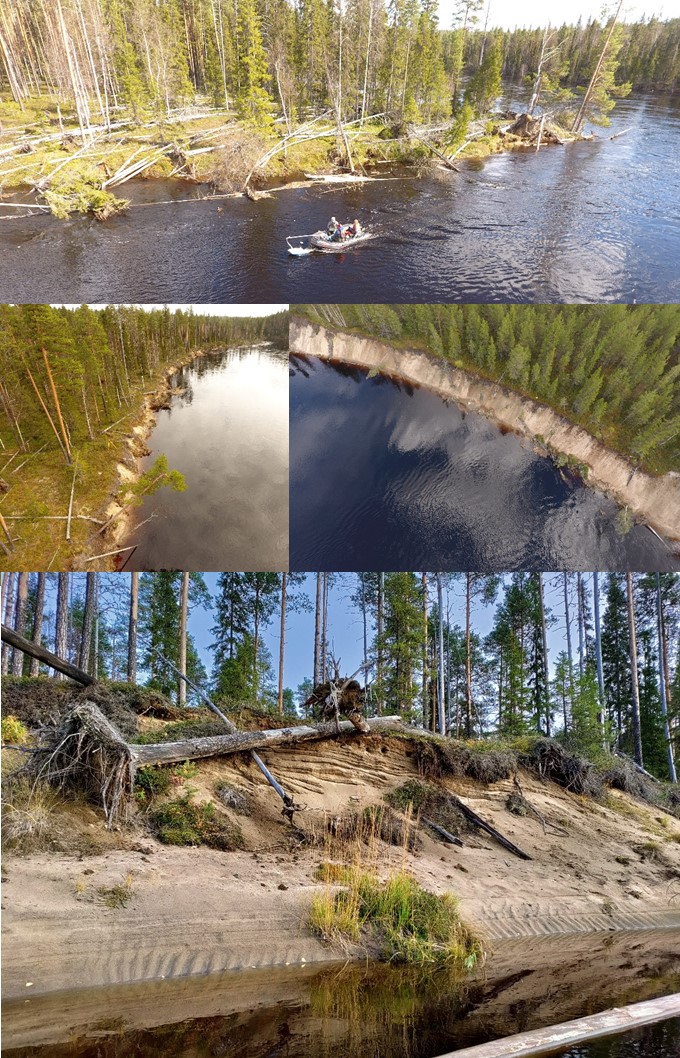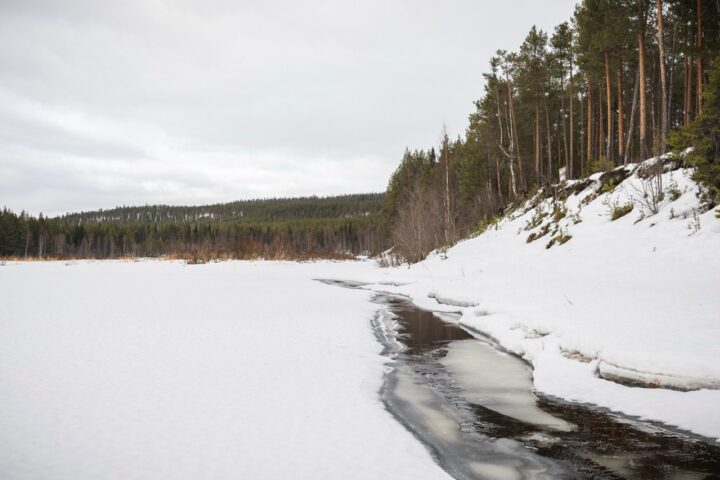When the Fever Spreads to Boreal Regions
What do you do when you have a fever? Can you continue with your daily routine as usual? Do you notice how it affects other parts of your body as well?
Now, think about this: how can the Earth cope with the fever it is experiencing? And how has this fever already spread to other parts of Earth’s systems, especially in the boreal regions?
This blog is about my first year of PhD exploration, a time when I feel I am pursuing the work I have long been interested in. Let’s explore together—if you’re curious about climate change and the changing rivers of the boreal environments.
Nature’s Rhythm and Its Disruption
Every natural phenomenon follows a rhythm, a pattern that unfolds over time. From bird migrations and growing seasons to river ice breakups and stream flows, nature runs on cycles. Even your own body is ruled by rhythms: your heart beats steadily to pump blood and nutrients.
But what happens when that rhythm is disrupted? When your heart skips a beat or falls out of sync, symptoms appear, and a doctor checks your pulse to find the cause. This is, in essence, what I do in my research.
I study whether boreal and subarctic environments are showing signs of illness, symptoms of imbalance caused by climate change and human activity. Are the hydrological processes in these regions falling out of sync? How severe are the changes? And what roles do climate and human influence play in driving them?
You’ve probably heard people say things like, “This year feels unusually warm,” or “Spring came too early,” or “I’ve never seen weather like this before.” These observations vary across regions: some face abnormal droughts, others experience unexpected wet spells, more frequent heatwaves, or extreme rainfall and flooding. These are not just casual remarks; they are symptoms. They reveal that something fundamental in nature’s rhythm is shifting, and the shift is happening fast.
One of the clearest symptoms is temperature. Imagine Earth as a living organism: right now, it has a fever that continues to rise. According to the Intergovernmental Panel on Climate Change (IPCC), the decade from 2013 to 2023 was the hottest ever recorded. Today, the average surface air temperature is about 1.2°C higher than it was in the late 1800s, before industrialization began. This raises an important question: what changes are occurring in the environment as a result?
How I Decided to Continue as a PhD and Ended Up in Finland
Climate change shows itself differently around the world. Some regions feel only mild effects, while others face dramatic transformations. I witnessed this firsthand in my childhood, spending wonderful years among my grandparents’ gardens and fields. Those green spaces hold some of my best memories. Sadly, they did not last. Water scarcity forced my grandparents to abandon their grape gardens, and today that land is either barren or a built-up area.
That experience planted a seed of curiosity in me. Later, during my bachelor’s studies in Civil Engineering, I became more drawn to water-related courses, and the seed began to grow as I became increasingly aware of how deeply climate change affects not only water resources but also many other sectors.
This passion led me to pursue a Master’s degree in Water Engineering, where I studied how climate change alters thermal seasons and precipitation patterns. At that time, I focused mainly on arid and semi-arid regions, where the effects of global warming are severe and obvious. During my MSc, I had the privilege of working with Professor Ali Torabi Haghighi from the University of Oulu as one of my supervisors. While working on my master’s thesis related to arid areas, I became curious and explored the research publications from his group. Through that exploration, I gradually gained a very different perspective on how climate change is affecting Northern Europe.
I was surprised to learn that high-latitude countries like Finland are warming faster than most other regions. Unlike the droughts I had often studied, some parts of Europe are actually becoming wetter. This contrasting climate behavior fascinated me. The complex challenges in Northern Europe, such as shifting snow dynamics, altered hydrological cycles, and ice breakups, which are uncommon in my region, made me even more interested in studying these environments.
As I followed more research from Finland, I became increasingly impressed by its academic environment and educational system. Finland’s commitment to sustainability, environmental research, and climate resilience stood out to me. Significant resources are being invested into finding solutions to global challenges, and I knew I wanted to be part of that effort. All of this made Finland a top choice for pursuing the next step in my academic journey.
Today, I am continuing that journey as a doctoral researcher in the UTU-GreDiT program at the University of Turku. I work with the Fluvial and Coastal Research Group, investigating how climate change and human activities are reshaping hydrological processes in boreal and subarctic environments. My role is to identify hydrological shifts and build a deeper understanding of climate-related consequences. I also try to develop digital sources to support future research and help accelerate global efforts toward sustainable solutions.
Fieldwork and First Insights
Soon after starting my PhD, I had the chance to join a fieldwork in northern Finland, where we measured and monitored the autumn river conditions of the Oulanka River. It was a transformative experience. I became familiar with carrying out geometric mapping and bathymetric surveys using unmanned surface vehicles and drones. These tools allowed us to see the shapes of riverbeds and the flow patterns in boreal catchments more clearly.
I also witnessed how snowmelt can be the main cause of large floods in these regions. Seeing this in practice changed my understanding of boreal hydrology and sparked new questions in my mind about seasonal transitions and their effects on ecosystems.
Hydrology in a Boreal Landscape
Hydrology is the study of how water moves through the environment. Finland is a snow-dominated country. Its hydrological cycle is closely linked to snow dynamics, and snow is highly sensitive to temperature. Considering that Finland’s temperature has been rising at nearly twice the global average rate, a critical question arises: how does this “severe fever” affect Finland’s systems?
The answer is both simple and complex. For example, sea level rise, a well-known consequence of global warming, does not pose a direct threat to Finland. Why? Because the country’s landmass is still rising due to post-glacial rebound. However, this does not mean Finland is immune. Other sectors such as agriculture, energy, business, and especially hydrology, have been dramatically affected.
Let us take a quick tour of Finland’s rivers and see how boreal hydrology is responding to climate change. The seasonal cycle has shifted. Springs and summers are now longer, while winters are shorter. This change has significantly altered the timing of snowmelt. The heavy water load that typically arrives in late spring now comes earlier, and its magnitude has changed. These shifts in peak flow timing and intensity are disrupting agricultural practices and affecting ecosystems whose life cycles are tightly synchronized with river rhythms.
Moreover, snowmelt-driven floods are reshaping river morphology. Large meanders are forming, and bank erosion is intensifying, especially during high-flow events in the spring. The photos from the Oulanka River show how snowmelt floods are eroding river banks and reshaping meanders. These images were taken by the Fluvial and Coastal Research Group, and thanks to Linnea Blåfield, postdoctoral researcher in the Department of Geography, for sharing these photos and her experiences. These physical changes are not just hydrological; they ripple through the landscape, affecting biodiversity, land use, and even infrastructure.

Photos taken by the Fluvial and Coastal Research Group, Department of Geography, University of Turku, during fieldwork at the Oulanka River.
Future Steps
To better understand how climate change is shaping hydrology in boreal and high-latitude regions, we decided to step back and look at the bigger picture.
Our focus turned to thermal seasons, which are defined by temperature thresholds instead of calendar dates. In boreal regions, spring is the most hydrologically important season. It also plays a key role for plants and animals, influencing bird migration, mating cycles, and vegetation growth.
By defining thermal seasons across Finland, we hope to see how global warming and atmospheric changes are reshaping these natural cycles. The aim is to identify what drives these seasonal shifts and to assess their impact on spring floods, which are among the most powerful hydrological events in boreal catchments. Through this research, I hope to add to our understanding of climate impacts and take one step closer to finding solutions.
Every Moment is a Precious Training Experience in the PhD Journey
Doing a PhD is like running a marathon. I remember Professor Petteri Alho, the director of our program, saying this during our first welcome session. Thirteen months in, I finally understand what he meant.
The workload can be demanding, with courses, conferences, meetings, and research deadlines often piling up. But there is also support along the way. Supervisors provide guidance and perspective, and in Finland, the strong culture of work-life balance helps keep both well-being and productivity in focus.
Like nature itself, the PhD journey has its cycles of ups and downs, breakthroughs and setbacks. What matters most is learning to enjoy the process. Every step forward, every question asked, and every answer discovered is part of the growth. As PhD researchers, we are in a unique position where asking questions is not only allowed but encouraged. That is a privilege, and it is worth embracing—because curiosity is the heart of research, and it is what carries us through the marathon.
Follow Sadegh on LinkedIn!
 Co-funded by the European Union. Views and opinions expressed are however those of the author(s) only and do not necessarily reflect those of the European Union or European Research Executive Agency (REA). Neither the European Union nor REA can be held responsible for them.
Co-funded by the European Union. Views and opinions expressed are however those of the author(s) only and do not necessarily reflect those of the European Union or European Research Executive Agency (REA). Neither the European Union nor REA can be held responsible for them.
